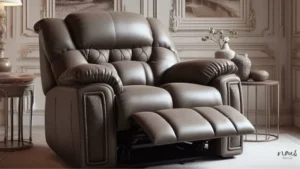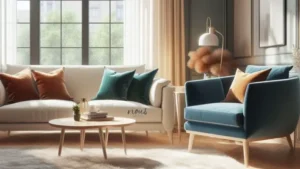Decorating with a burgundy sofa can be a tricky endeavor. With the wrong colors, your room could end up looking dull and lifeless. To make sure you get Burgundy Sofa What Colour Walls right, you need to understand the undertones of your sofa and consider the color wheel as well.
You should also decide on a neutral color scheme or choose bold colors for contrast. Earthy hues will add depth, while colorful accents will keep the room from looking too flat. Before committing to any paint colors, always test them out first.
Finally, don’t forget to incorporate patterns and textures into your design for an extra layer of interest with Nousdecor!
Key Takeaways of Burgundy Sofa What Colour Walls
- Understanding the undertones of your burgundy sofa and considering the color wheel is important when choosing wall colors.
- Neutral color schemes or bold colors can be chosen for contrast with a burgundy sofa.
- Wall colors such as light taupe, pale gray, navy blue, olive green, and yellow can complement a burgundy sofa.
- Incorporating patterns, textures, and colorful accent pieces can add interest and depth to a room with a burgundy sofa.
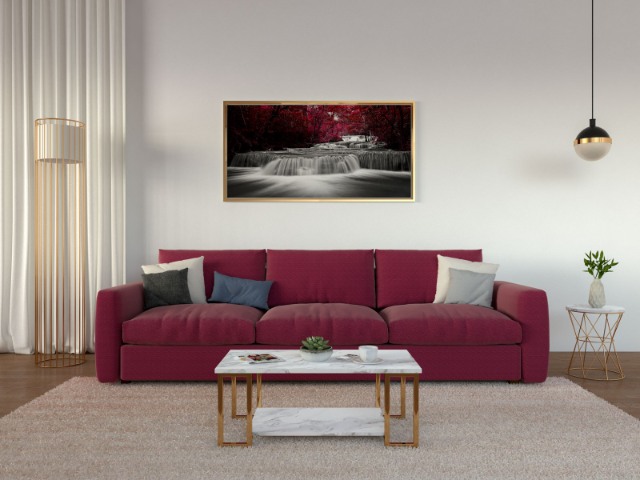
Consider the Undertones in Your Burgundy Sofa
When choosing wall colors to pair with your burgundy sofa, consider the undertones in the fabric – it’ll give you a look you’ll love!
Understanding how to choose complementary colors for a room starts with understanding the color wheel. Warm colors like red, yellow and orange are on one side of the wheel while cool hues like blue, green and purple are on the other.
Burgundy is a mix of red and blue so it has both warm and cool tones. To bring out any underlying warm or cool tones in your sofa fabric, choose shades that are similarly toned from the color wheel.
Neutrals like gray, beige or white can also be great companions for burgundy furniture as they don’t clash with either warm or cool tones. These colors can provide an elegant background for more vibrant accents such as pillows or artwork.
If you want something bolder, try pairing your burgundy sofa with navy blue walls. This combination works well because navy blue contains hints of both red and purple which will complement the undertone of your burgundy couch nicely.
Choosing complementary wall colors for a room is easy if you know how to read the color wheel properly. By recognizing which tones exist in your furniture piece and selecting shades accordingly, you can create a balanced space that looks beautiful no matter what style you’re going for!
Also, if you’re interested in blue sofa, check out our article on complementary hues with blue sofa as well!
To get started on this endeavor, take some time to study up on different colors and their undertones – it’s worth the effort!
Understand the Color Wheel
Knowing how to use the color wheel is key for creating a visually pleasing room, without clashing colors. The traditional Color Wheel uses 12 colors based on the three primary hues of red, yellow and blue.
These are then broken down into tertiary colors which are made by combining two secondary colors together such as orange (red + yellow) or violet (blue + red). Using this method allows us to create a range of harmonious shades that can be used in combination with our burgundy sofa. Here are some ways to use the Color Wheel:
- Understand complementary colors – these are opposite each other on the wheel and include pairs like blue/orange, purple/yellow and green/red.
- Identify analogous colors – these sit side-by-side on the wheel such as red-violet and yellow-green.
- Use split complementary colors – combinations like blue & orange-red, yellow & violet-red or green & violet-blue.
- Choose contrasting tones – select two different shades from opposite sides of the wheel such as light pink & dark navy.
Using these techniques you can determine what wall color will look best with your burgundy sofa when considering both hue and saturation levels.
With this knowledge in hand, it’s time to choose a neutral color scheme for your walls that will provide an ideal backdrop for all of your furniture pieces including your burgundy sofa.
Choose a Neutral Color Scheme
Deciding on a neutral color scheme for your room can be tricky, but with the right knowledge you can create a stunning space. For example, if you have a burgundy sofa, then you’ll want to pick colors that won’t clash with it.
A good place to start is by looking at the color wheel and seeing which shades of neutrals are harmonious with red. Shades of tan, gray and beige will all go nicely together and provide an overall warm feel in the room. Using different textures in these shades will also help add depth and interest to the space.
In terms of what wall colors to choose, light taupe or pale gray could both work nicely as they won’t compete with the burgundy sofa for attention.
You could even incorporate some muted yellows or greens into your palette if you wanted something more vibrant yet still neutral-toned. The key thing is to make sure that whichever shades you go with do not overwhelm each other when placed side-by-side.
To really pull your look together, think about adding accent pieces such as cushions or throws in complementary colors like navy blue or olive green that stand out against the neutrals without clashing too much.
Adding texture through wallpapers or rugs can also add visual interest while maintaining balance in your color scheme.
With all these elements working together, you should be able to create a beautiful space for relaxing and entertaining friends and family alike – no matter what color couch it has!
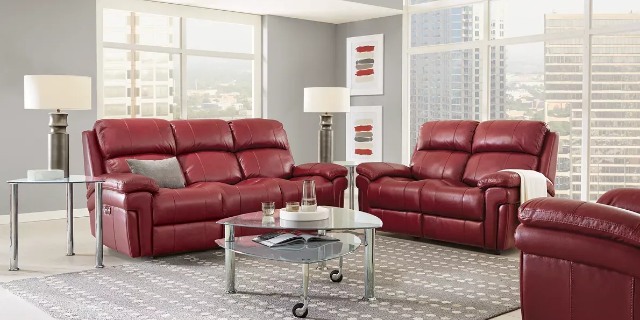
Create Contrast with Bold Colors
My goal is to explore how to create contrast with bold colors. Specifically, I will discuss the use of blue, green and yellow. Blue can be used to add a calming effect to any space while green is often associated with nature and the outdoors. Yellow is known for its cheerful vibrancy and can be used to energize a room or bring attention an area.
Together, these three colors can provide an interesting visual contrast when used together in a single space.
Blue
Adding a blue wall to your burgundy sofa will create a striking, elegant contrast. Combining these two colors in one room can give you an eye-catching look that stands out from the rest.
The deep, dark hue of the burgundy paired with the bright and vibrant blue can be used to make any room look more interesting and unique.
Blue walls are also a great way to tie together other colors in your space such as grey or white accents. With this combination, you can make a statement without going too bold and overwhelming the entire space.
Creating balance between these two tones is essential for creating an inviting atmosphere no matter what type of design style you’re trying for. Ultimately, a blue wall with a burgundy sofa creates an exciting pairing that adds depth and sophistication to any room.
By implementing this color scheme, you’ll have an interior that brings attention yet still maintains its welcoming aura. Moving on to green…
Green
You can create a stunning look in your home by pairing a green sofa with blue walls.
Green is a versatile color that can be used to create both calming and stimulating environments, depending on the shade you choose. With its natural connection to nature, green is an ideal choice for any space looking to evoke feelings of tranquility and serenity.
To achieve this effect, opt for muted shades such as sage or olive green top sofas for home. You can then pair them with light blue wall colors like baby blue or powder blues to help tie together the two colors and create a cool, inviting atmosphere.
For more impactful results, use darker shades of these hues to craft a bolder design aesthetic. In addition to walls and furniture pieces, adding green-hued accessories like cushions or curtains will further enhance the overall ambience of your room.
Moving forward, yellow is another great option for creating an inviting atmosphere in your home when paired with burgundy sofas.
Yellow
From the bold and vibrant greens, one might consider transitioning to warm and inviting yellows. A burgundy sofa with yellow walls creates a welcoming atmosphere in any space. To make it even more inviting, consider these elements:
- Richly patterned rugs
- Bold artwork
- Sunlight-catching accents
- Textured throw pillows
These touches add vibrancy to the room without overwhelming it, making it perfect for entertaining or simply relaxing. For an even more complete look, adding depth with earthy hues is the next step.
Add Depth with Earthy Hues
Create a beautiful, earthy backdrop for your burgundy sofa by choosing walls of complementary hues. Rich browns and warm reds create an inviting atmosphere, while cooler shades of green and blue can add a sense of calmness to the room.
Consider using colors like terracotta or mustard yellow to add depth and bring out subtle tones in the sofa fabric. You could even try pairing it with deep navy to create an unexpected contrast in the space.
To make sure your walls don’t overpower the sofa, consider keeping them more muted than the vibrant burgundy color of the sofa itself. Choose colors that are slightly lighter or darker than it, then use accent pieces such as throw pillows or wall art to bring more life into the room.
This will not only draw attention to your furniture but also give you a chance to experiment with different color combinations without making drastic changes throughout the entire room.
Accessorizing with colorful accents is another great way to enhance your decor while bringing out natural highlights in both your walls and furniture. Brightly colored artwork or textiles can be used to liven up any dull spots without taking away from its overall look and feel.
With these simple tips, you can easily turn your living space into a stylish sanctuary that reflects both comfort and personality!
Accessorize with Colorful Accents
Add a pop of vibrancy to your living space by accessorizing with colorful accents. Colorful accent pieces can be great for adding visual interest to any room, and when paired with a burgundy sofa they can really make the look come alive.
Throw pillows, area rugs, and wall art are all perfect additions for bringing in a bit of color while still keeping the overall look balanced. Just remember not to go overboard – too much color can quickly become overwhelming.
When selecting items for your room, keep in mind that the colors should complement each other. Select items that have similar hues or shades so that they don’t conflict or clash with one another.
Consider adding some neutral pieces into the mix as well such as white or cream colored items which will help break up the intensity of brighter colors without taking away from their impact.
It’s also important to pay attention to how much light is already in the room before you begin shopping for accessories. If there isn’t enough natural light present, consider incorporating lighter tones that won’t appear dull when exposed to artificial lighting sources during evening hours.
On the other hand, if there is plenty of natural light available then bolder shades would work best as they will help bring out all of those vibrant tones even more!
Accessorizing may seem like an easy task but it takes careful consideration and thoughtfulness when pairing colors together in order to create a cohesive look that highlights both your burgundy sofa and chosen wall colors effectively.
Before you commit yourself to any decisions on what accent pieces you should use it’s always wise practice to test paint samples on walls first so you know exactly how different shades will work together before investing in anything new!

Test Paint Colors Before Committing
Before you commit to any new color combinations for your living space, it’s best to test out paint samples on the walls to get a better idea of how they’ll look together. Painting sample patches on the wall will help you decide if a combination of colors is harmonious or clashing.
| Sample 1 | Sample 2 | Sample 3 |
|---|---|---|
| Color A | Color B | Color C |
| Color D | Color E | Color F |
| Color G | Color H | Color I |
It pays to be patient and take your time when deciding on a color scheme for your home. Try different shades of the same color to find the one that works best with your furniture, as well as experimenting with bolder hues. Some colors may appear too vibrant in certain lighting conditions; make sure you consider this before committing to a wall color.
Think about how textures can add depth and interest to an otherwise plain wall. Wallpapers, textured paints, or even faux finishes can add subtle details to an area without overpowering it with too much color. You could also choose some coordinating accessories that bring out the richness of the wall paint while still blending into its surroundings.
Transforming a room doesn’t have to be difficult; careful planning combined with thoughtful execution can ensure you end up with an inviting and stylish space that reflects who you are and what makes you happy.
With all these tips in mind, you should have no problem creating beautiful walls that not just enhance your burgundy sofa but help in decorating a dark brown sofa living room as well!
Incorporate Patterns and Textures
Now that I have tested and selected a paint color for the walls to accompany my burgundy sofa, it is time to think about incorporating patterns and textures.
To do this, I should consider the style of the room; if it’s modern or traditional, for example. It is important to ensure that any pattern or texture used complements and enhances the overall look of the room.
One great way to add interest without overwhelming a space is by using a patterned wallpaper on one wall only. By doing this, you can create an accent wall while also introducing a unique texture or pattern that will work with your chosen colors.
If going with wallpaper isn’t your thing, then there are many other options available such as wood paneling, textured paint, stone tile accents or even brickwork.
To keep things unified in the room while still adding some extra depth and personality, you can incorporate smaller touches like throw pillows with coordinating patterns and textures to match those found on either your sofa or walls. Adding area rugs in matching hues can also be useful in tying together all of the different elements within your space for a cohesive look.
When selecting furniture pieces to go along with your burgundy sofa, you should pay attention to their shapes too; choosing items with curved lines creates contrast against more angular furniture pieces like tables or dressers which will draw attention away from any potential monotony due to limited color selection.
With careful thought put into every detail of design – from colors down to materials – you can create an inviting atmosphere perfect for both relaxation and entertaining guests alike!
Your sofa is a beige one? Check out our article on beige sofa color combinations now!
Frequently Asked Questions
Conclusion
When it comes to choosing wall colors for a burgundy sofa, there are many different options. It’s important to consider the underlying tones in the sofa and understand how they fit into the color wheel.
Neutral colors like beige and gray can help create a calming atmosphere, while bolder shades will bring contrast. Earthy hues can add depth, while colorful accents can brighten up the space.
Don’t forget to test paint samples before committing – this way you can see how the colors work together in your own living room! And if your sofa is a black one, check out our article on What Colours Go With A Black Sofa now!


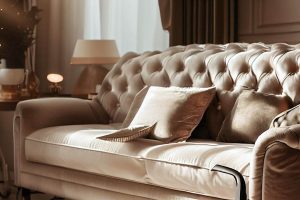
![Murphy Bed vs Sofa Bed: What’s the Difference? [2024]](https://nousdecor.com/wp-content/uploads/2021/06/Murphy-Bed-vs-Sofa-Bed-300x210.jpg)
